
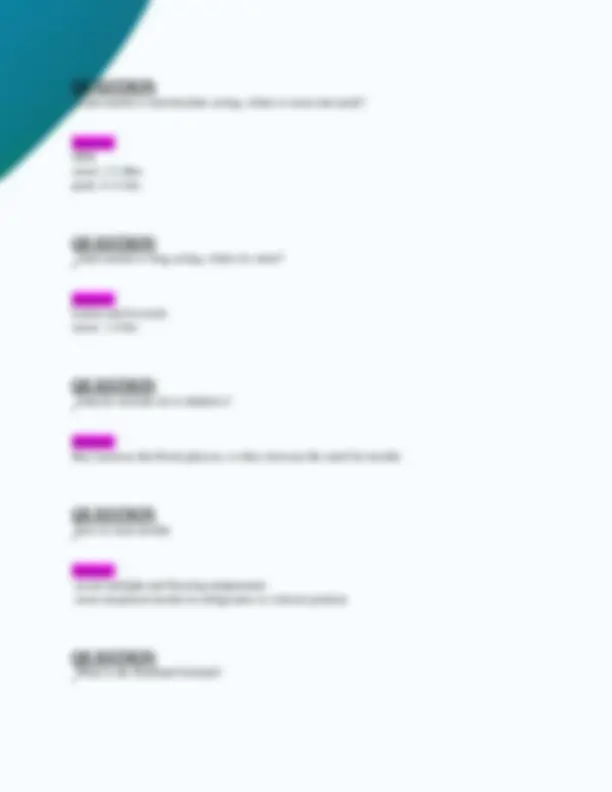
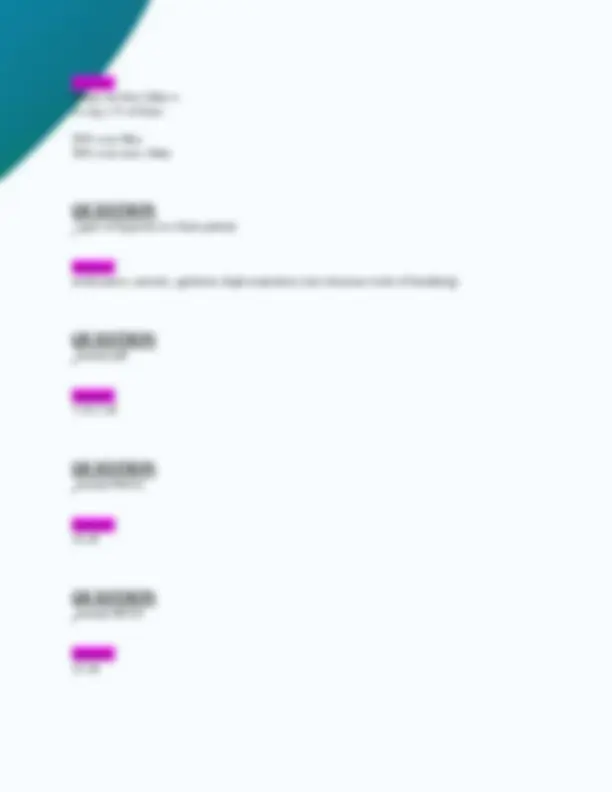
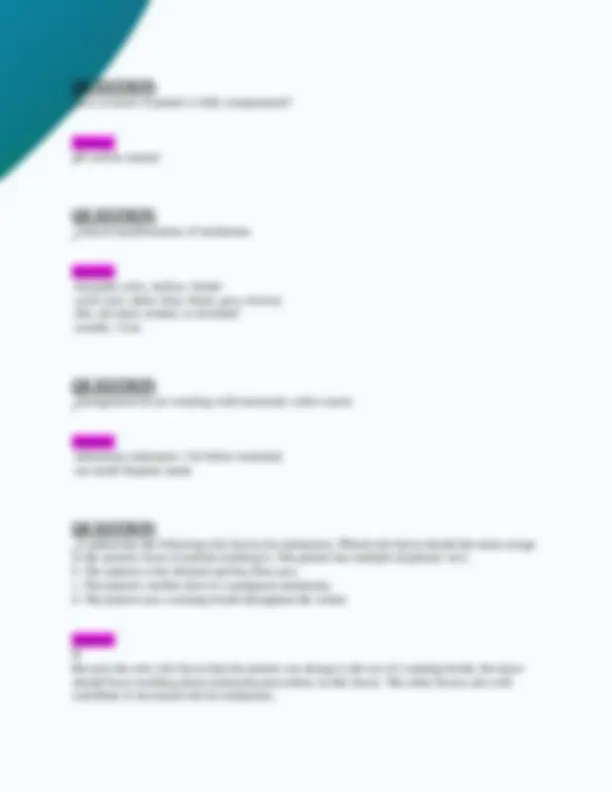
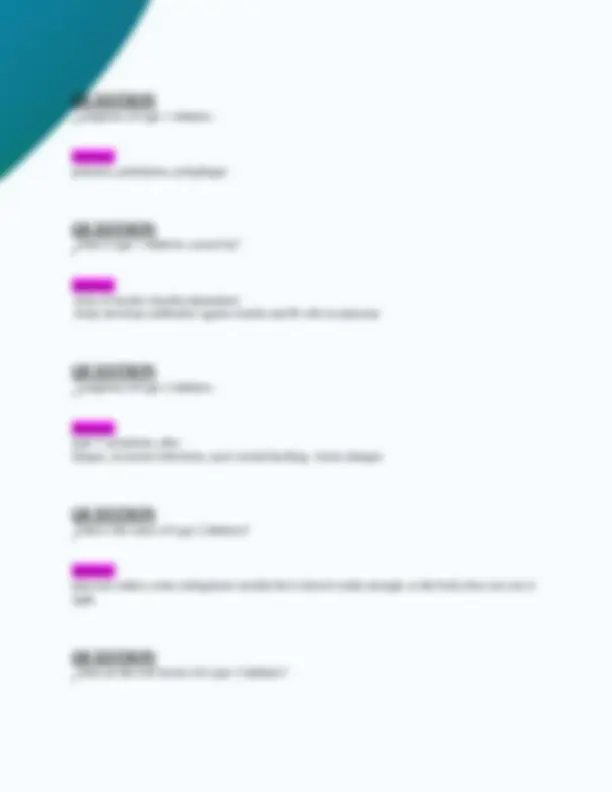

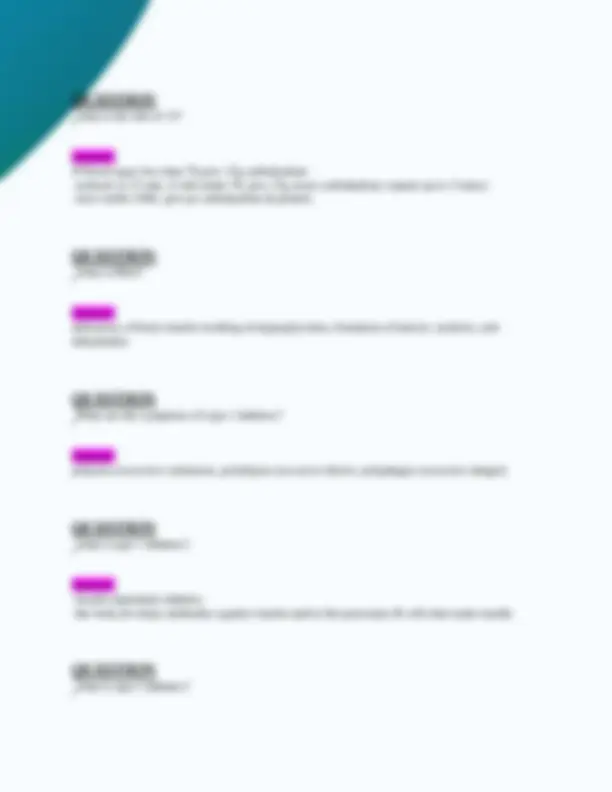
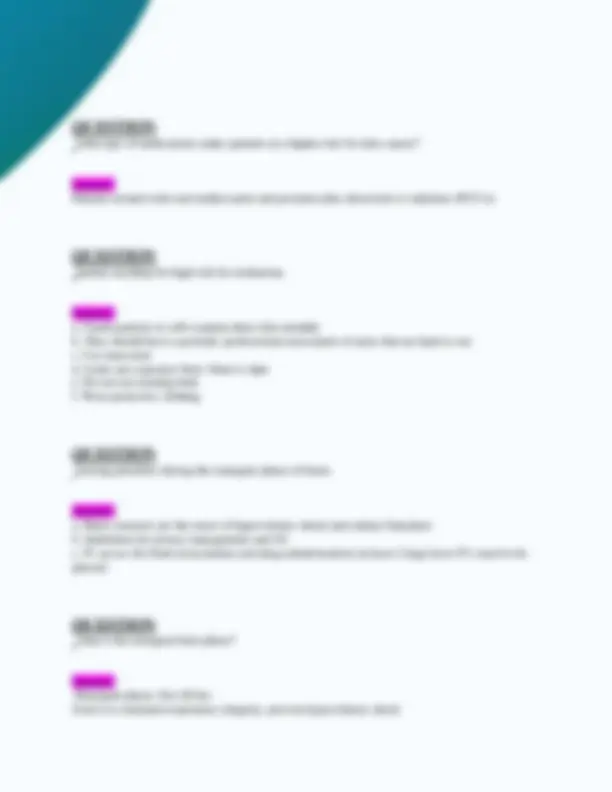
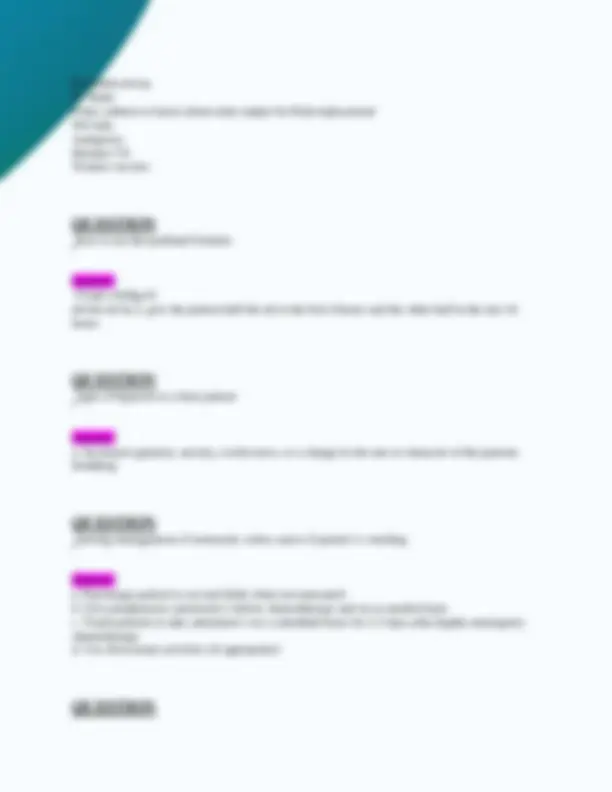
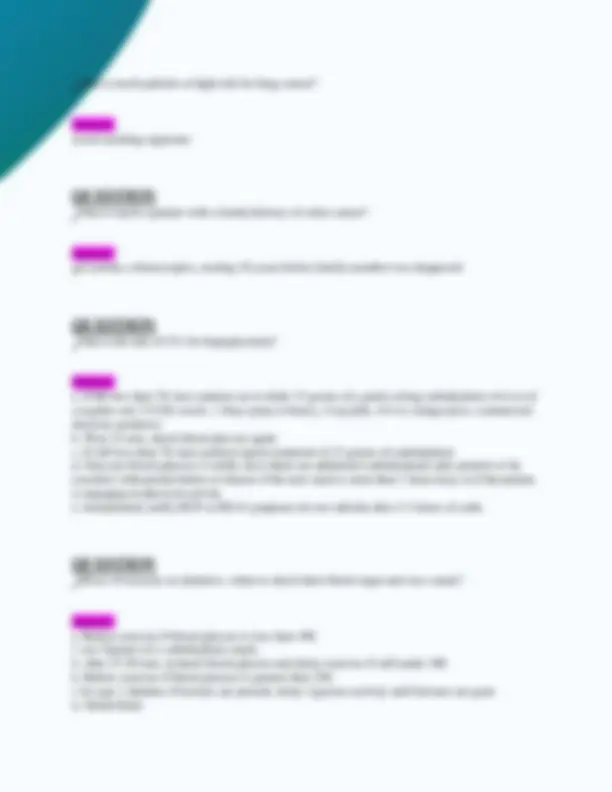
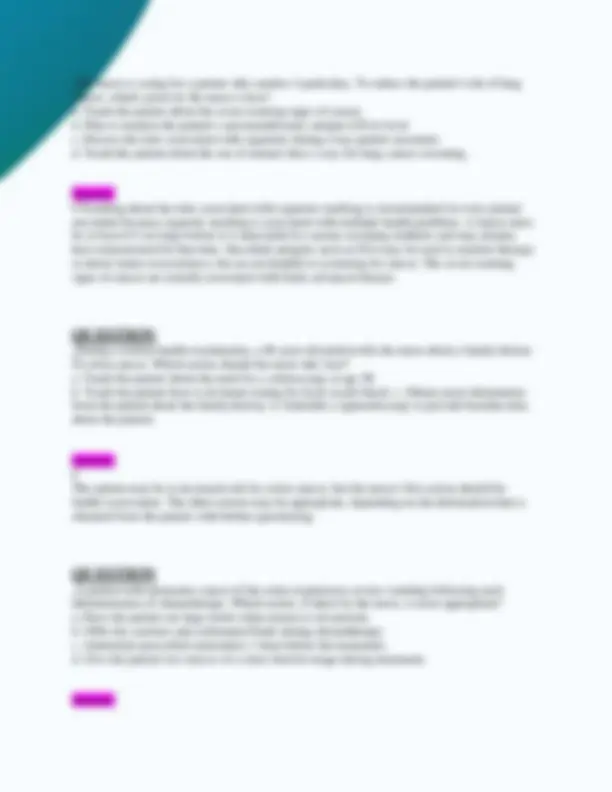
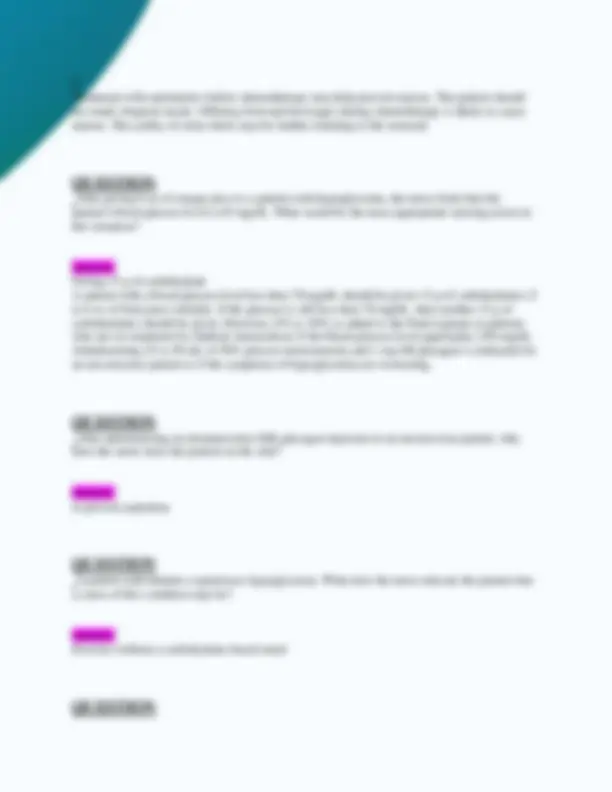
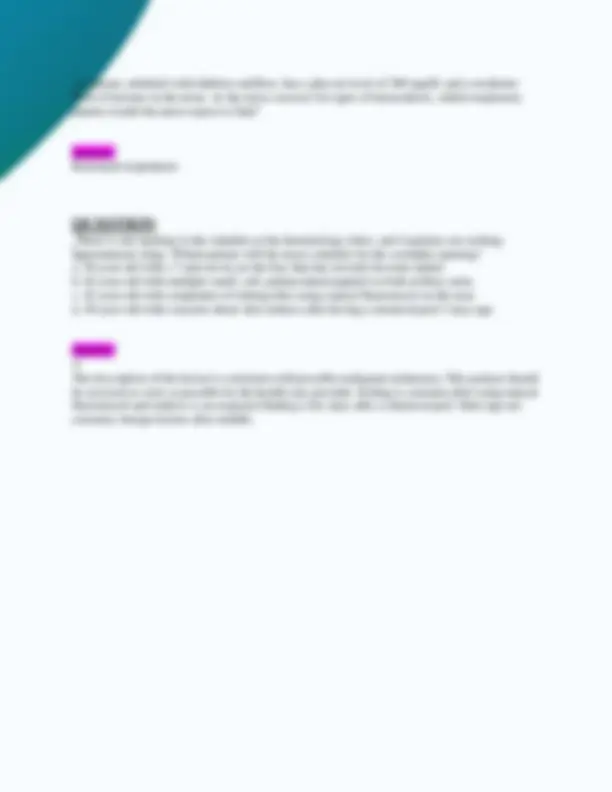


Study with the several resources on Docsity

Earn points by helping other students or get them with a premium plan


Prepare for your exams
Study with the several resources on Docsity

Earn points to download
Earn points by helping other students or get them with a premium plan
Community
Ask the community for help and clear up your study doubts
Discover the best universities in your country according to Docsity users
Free resources
Download our free guides on studying techniques, anxiety management strategies, and thesis advice from Docsity tutors
Exam 1: NUR209/ NUR 209 (New 2025/ 2026 Update) Medical Surgical Nursing II | Questions and Verified Answers| 100% Correct| A Grade – Fortis
Typology: Exams
1 / 20

This page cannot be seen from the preview
Don't miss anything!













what should a patient do if their blood sugar is 100 before they start exercising? Answer: they should eat 15g of a carbohydrate, recheck in 15 - 30 min and delay exercise if still under 100
what should a patient do if their blood sugar is above 250 before exercise? Answer: check urine for ketones if type 1 diabetic (delay vigorous activity is present)
how long can hypoglycemia occur after exercise? Answer: up to 48 hours
What is the A1C goal for diabetics? Answer: 6.5%-7.0%
how often should a diabetic check their A1C? Answer: every 3 - 6 months
signs of DKA Answer:
what insulin is rapid acting? whats its onset and peak? Answer: Humalog and Novolog
what insulin is short acting, what its onset and peak? Answer: Regular, Humalin, Novalin onset: 30-60 min peak: 2 - 5 hrs
Answer: Fluids for first 24hrs = 4 x kg x % of burn 50% over 8hrs 50% over next 16hrs
signs of hypoxia in a burn patient Answer: restlessness, anxiety, agitation, high respiratory rate (increase work of breathing)
normal pH Answer: 7.35-7.
normal PaCo Answer: 35 - 45
normal HCO Answer: 22 - 26
how to know if patient is fully compensated? Answer: pH will be normal
clinical manifestations of melanoma Answer:
management for pt vomiting with metastatic colon cancer Answer:
A patient has the following risk factors for melanoma. Which risk factor should the nurse assign as the priority focus of patient teaching?a. The patient has multiple dysplastic nevi. b. The patient is fair-skinned and has blue eyes. c. The patient's mother died of a malignant melanoma. d. The patient uses a tanning booth throughout the winter. Answer: D Because the only risk factor that the patient can change is the use of a tanning booth, the nurse should focus teaching about melanoma prevention on this factor. The other factors also will contribute to increased risk for melanoma.
Answer: 2, 3, 5 Excessive thirst, frequent urination, and unexplained weight loss are clinical symptoms of both type 1 and type 2 diabetes mellitus. Fatigue and recurrent infections are clinical manifestations of type 2 diabetes.Text Reference - p. 1157
Which symptom reported by a patient would lead the nurse to suspect early undiagnosed type 2 diabetes? 1Blurred vision 2Gradual weight gain 3A wound that will not heal 4Insomnia Answer: 3 Type 2 diabetes presents with vague complaints including fatigue, frequent infections, and delayed wound healing. Blurred vision is a late symptom of uncontrolled diabetes. The patient will present with weight loss. Insomnia is not related to symptoms of undiagnosed diabetes.
A patient is prescribed lispro therapy. Related to meal times, the nurse should instruct the patient to administer the insulin when?
symptoms of type 1 diabetes Answer: polyuria, polydipsia, polyphagia
what is type 1 diabetes caused by? Answer:
symptoms of type 2 diabetes Answer: type 1 symptoms, plus fatigue, recurrent infections, poor wound healing, vision changes
what is the cause of type 2 diabetes? Answer: pancreas makes some endogenous insulin but it doesn't make enough, or the body does not use it right
what are the risk factors for type 2 diabetes?
what is the rule of 15? Answer: if blood sugar less than 70 give 15g carbohydrate
what is DKA? Answer: deficiency of body insulin resulting in hyperglycemia, formation of ketosis, acidosis, and dehydration
What are the symptoms of type 1 diabetes? Answer: polyuria (excessive urination), polydipsia (excessive thirst), polyphagia (excessive hunger)
what is type 1 diabetes? Answer:
what is type 2 diabetes?
Answer: adult-onset or non-insulin dependent diabetes
what are the symptoms of type 2 diabetes? Answer: fatigue, recurrent infections, vaginal yeast or candid infections, prolonged wound healing, and vision problems
what is hypoglycemia? Answer: when there is too much insulin in proportion to available glucose in the blood
what are the assessment findings of hypoglycemia? Answer:
what type of medications make patients at a higher risk for skin cancer? Answer: Patients treated with oral methoxsalen and psoralen plus ultraviolet A radiation (PUVA)
patient teaching for high risk for melanoma Answer: a. Teach patients to self-examine their skin monthly b. They should have a periodic professional assessment of areas that are hard to see c. Use sunscreen d. Limit sun exposure from 10am to 4pm e. Do not use tanning beds f. Wear protective clothing
nursing priorities during the emergent phase of burns Answer: a. Main concerns are the onset of hypovolemic shock and edema formation b. Intubation for airway management and O c. IV access for fluid resuscitation and drug administration (at least 2 large bore IV's need to be placed)
what is the emergent burn phase? Answer:
Establish airway IV fluids Foley catheter to know about urine output for fluid replacement NG tube Analgesics Monitor VS Tetanus vaccine
how to use the parkland formula Answer:
signs of hypoxia in a burn patient Answer: a. Increased agitation, anxiety, restlessness, or a change in the rate or character of the patients breathing
nursing management of metastatic colon cancer if patient is vomiting Answer: a. Encourage patient to eat and drink when not nauseated b. Give prophylactic antiemetic's before chemotherapy and on as-needed basis c. Teach patients to take antiemetic's on a scheduled basis for 2 - 3 days after highly emetogenic chemotherapy d. Use diversional activities (if appropriate)
what does the ADA recommend for physical activities for a person with diabetes? Answer: recommends at least 150 minutes per week of moderate physical activity a. Active housework b. Bicycling c. Bowling d. Dancing e. Gardening f. Golf g. Roller skating h. Walking briskly
What is hemoglobin A1C? Answer: a. A1C provides a measurement of blood glucose levels over the previous 2 - 3 months, with increases in the Hb A1C reflecting elevated blood glucose levels b. A1C is monitored regularly to determine how well the current treatment plan is working and changes can be made in the plan if glycemic goals are not achieved
patient teaching for a diabetic taking steroids Answer: a. Check blood sugar more often b. Increase the dose of insulin if needed c. Monitor urine or blood ketones
how to prevent DKA?
Answer:
patient teaching for type 2 diabetes Answer: a. Healthy eating, regular exercise, and healthy weight, may need medication as the disease progresses
How to assess hypoglycemia in a sleeping or unconscious patient? Answer: a. check the blood glucose b. If pt is unconscious: subcutaneous or IM injection of 1mg glucagon or IV administration of 20 - 50ml of 50% glucose and turn the patient on their side to prevent aspiration
what is DKA? Answer: deficiency of body insulin resulting in hyperglycemia, formation of ketoacids, osmotic diuresis, and metabolic acidosis
Treatment with antiemetics before chemotherapy may help prevent nausea. The patient should eat small, frequent meals. Offering food and beverages during chemotherapy is likely to cause nausea. The acidity of citrus fruits may be further irritating to the stomach
After giving 6 oz of orange juice to a patient with hypoglycemia, the nurse finds that the patient's blood glucose level is 65 mg/dL. What would be the most appropriate nursing action in this situation? Answer: Giving 15 g of carbohydrate A patient with a blood glucose level less than 70 mg/dL should be given 15 g of carbohydrates ( to 6 oz of fruit juice) initially. If the glucose is still less than 70 mg/dL, then another 15 g of carbohydrates should be given. Dextrose (5% to 10%) is added to the fluid regimen in patients who are on treatment for diabetic ketoacidosis if the blood glucose level approaches 250 mg/dL. Administering 25 to 50 mL of 50% glucose intravenously and 1 mg IM glucagon is indicated for an unconscious patient or if the symptoms of hypoglycemia are worsening.
After administering an intramuscular (IM) glucagon injection in an unconscious patient, why does the nurse turns the patient on the side? Answer: to prevent aspiration
A patient with diabetes experiences hypoglycemia. What does the nurse educate the patient that a cause of this condition may be? Answer: Exercise without a carbohydrate-based snack
A patient, admitted with diabetes mellitus, has a glucose level of 380 mg/dL and a moderate level of ketones in the urine. As the nurse assesses for signs of ketoacidosis, which respiratory pattern would the nurse expect to find? Answer: Kussmaul respirations
There is one opening in the schedule at the dermatology clinic, and 4 patients are seeking appointments today. Which patient will the nurse schedule for the available opening? a. 38 - year old with a 7 - mm nevus on the face that has recently become darker b. 62 - year-old with multiple small, soft, pedunculated papules in both axillary areas c. 42 - year-old with complaints of itching after using topical fluorouracil on the nose d. 50 - year-old with concerns about skin redness after having a chemical peel 3 days ago Answer: A The description of the lesion is consistent with possible malignant melanoma. This patient should be assessed as soon as possible by the health care provider. Itching is common after using topical fluorouracil and redness is an expected finding a few days after a chemical peel. Skin tags are common, benign lesions after midlife.